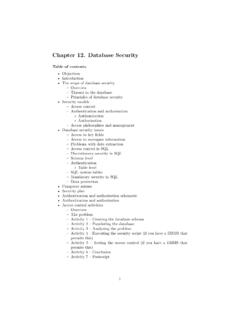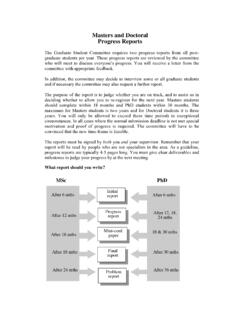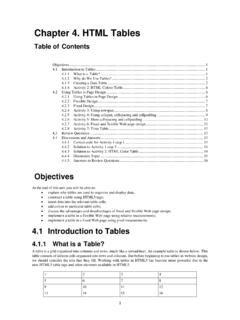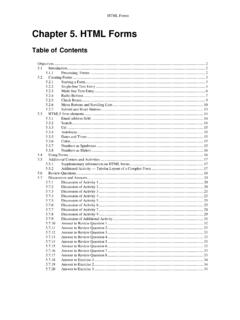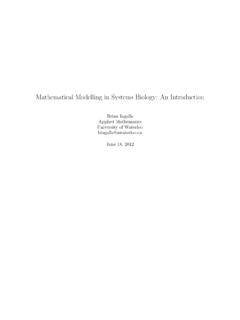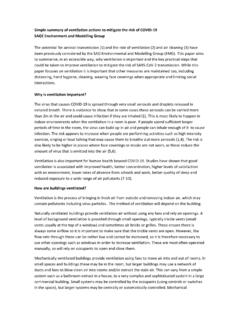Transcription of Chapter 6. Data-Flow Diagrams
1 1 Chapter 6. Data-Flow DiagramsTable of ContentsObjectives .. 1 Introduction to Data-Flow Diagrams .. 2 What are Data-Flow Diagrams ? .. 2An example Data-Flow diagram .. 2 The benefits of Data-Flow Diagrams .. 3 Case study .. 3 The different kinds (and levels) of Data-Flow Diagrams .. 3 Elements of Data-Flow Diagrams .. 4 Processes .. 4 data -flows .. 5 data stores .. 6 External entities .. 7 Multiple copies of entities and data stores on the same diagram.
2 8 Context Diagrams .. 8 What is a context diagram? .. 8 Constructing a context diagram .. 9 Level 1 Data-Flow Diagrams .. 9 What is a level 1 DFD? .. 9 Constructing level 1 DFDs .. 10 Decomposing Diagrams into level 2 and lower hierarchical levels .. 10 What is a level 2 (or lower) DFD? .. 11 Constructing level 2 (and lower) DFDs functional decomposition .. 11 Making levels .. 12 Balancing .. 13 Numbering .. 13 Process descriptions.
3 13 Validation .. 14An example in constructing a Data-Flow diagram .. 14 Identify the system boundaries .. 15 Follow inputs .. 15 Follow events .. 16 Fill in gaps .. 17 Repeat .. 17 Review .. 18 Questions .. 18 Answers .. 21 ObjectivesAt the end of this Chapter you should be able to: Explain the purpose of Data-Flow Diagrams . Describe the meaning of the symbols used in Data-Flow Diagrams . Describe the generic framework activities at which data flow Diagrams can be used and thecorresponding roles of Data-Flow Diagrams in these stages.
4 Construct simple Data-Flow Diagrams from a textual description. Construct a levelled set of Data-Flow Diagrams2 Understand how to check the consistency of related Data-Flow to Data-Flow diagramsWhat are Data-Flow Diagrams ? Data-Flow Diagrams (DFDs) model a perspective of the system that is most readily understood by users the flow of information through the system and the activities that process this Diagrams provide a graphical representation of the system that aims to be accessible tocomputer specialist and non-specialist users alike.
5 The models enable software engineers, customersand users to work together effectively during the analysis and specification of requirements. Althoughthis means that our customers are required to understand the modeling techniques and constructs, indata-flow modeling only a limited set of constructs are used, and the rules applied are designed to besimple and easy to follow. These same rules and constructs apply to all Data-Flow Diagrams ( , foreach of the different software process activities in which DFDs can be used).
6 An example Data-Flow diagramAn example of part of a Data-Flow diagram is given below. Do not worry about which parts of whatsystem this diagram is describing look at the diagram to get a feel for the symbols and notation ofa Data-Flow An example Data-Flow diagramAs can be seen, the DFD notation consists of only four main the activities carried out by the system which use and transform information. Processesare notated as rectangles with three parts, such as Order Supplies and Make Payments in theabove the data inputs to and outputs from to these activities.
7 data -flows are notated asnamed arrows, such as Delivery and Supply Order in the example entities the sources from which information flows into the system and the recipientsof information leaving the system. External entities are notated as ovals, such as Supplier in theexample stores where information is stored within the system. data stores are notated as rectangleswith two parts, such as Supplier Details and Orders in the example Diagrams are supplemented by supporting documentation including a data dictionary, describingthe contents of data -flows and data stores.
8 And process definitions, which provide detaileddescriptions of the processes identified in the Data-Flow benefits of Data-Flow diagramsData-flow Diagrams provide a very important tool for software engineering, for a number of reasons: The system scope and boundaries are clearly indicated on the Diagrams (more will be describedabout the boundaries of systems and each DFD later in this Chapter ). The technique of decomposition of high level Data-Flow Diagrams to a set of more detailed Diagrams ,provides an overall view of the complete system, as well as a more detailed breakdown anddescription of individual activities, where this is appropriate.
9 For clarification and Diagrams also provide a partition of a software-system into those things which areinside the system and those things which are outside of the studyWe shall be using the following case study to explore different aspects of Data-Flow modeling LTD case studyVideo-Rental LTD is a small video rental store. The store lends videos to customers for afee, and purchases its videos from a local customer wishing to borrow a video provides the empty box of the video they desire, theirmembership card, and payment payment is always with the credit card used to open thecustomer account.
10 The customer then returns the video to the store after watching a loaned video is overdue by a day the customer's credit card is charged, and a reminderletter is sent to them. Each day after that a further card is made, and each week a reminderletter is sent. This continues until either the customer returns the video, or the charges areequal to the cost of replacing the customers fill out a form with their personal details and credit card details, and thecounter staff give the new customer a membership card.

